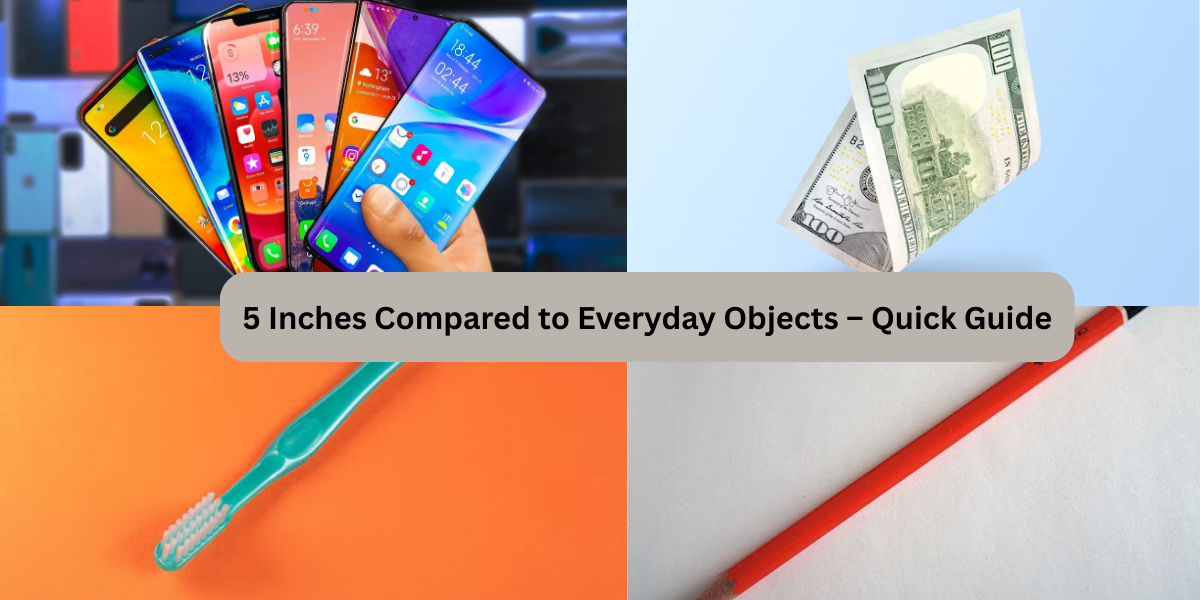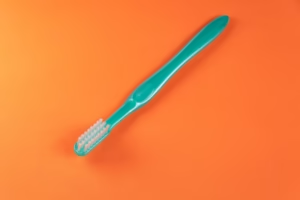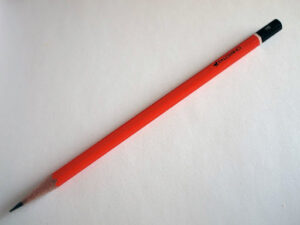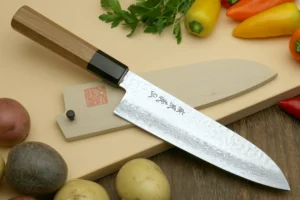Have you ever been stuck trying to visualize how long 5 inches really is? Whether you’re shopping online, doing a DIY project, or helping your child with homework, it’s surprisingly common to struggle with converting measurements into real-world size.
That’s why we’ve put together this detailed and easy-to-understand guide. By comparing 5 inches Compared to everyday objects, you’ll gain a clearer, more intuitive sense of the measurement—no ruler required. We’ll also dive into useful size comparisons, practical applications, and why this measurement comes up more often than you might expect
this is tool> feet to meters converter
How Long Is 5 Inches? A Quick Reference
Before we get into object comparisons, let’s first understand the basics:
- 5 inches = 12.7 centimeters
- 5 inches = 0.417 feet
- It’s just under half a foot in length
5 inches is a relatively small but significant measurement that appears in many daily tasks, especially when you’re working with handheld tools, screen sizes, fashion items, or even food packaging.
Why You Might Need to Visualize 5 Inches
Understanding what 5 inches looks like can be useful in many scenarios:
- Buying accessories online (bracelets, phone stands, etc.)
- Measuring space in drawers or shelves
- Visualizing injury sizes for medical purposes
- Estimating pet or plant growth
- Comparing screen sizes or small tools
Knowing real-world equivalents helps avoid misjudging sizes and making returns or corrections later.
5 Inches Compared to Everyday Objects – Quick Guide
To help you get a better feel for how long 5 inches is, here are some real-world objects that are approximately the same length:
1. Smartphones (Smaller Models)
If you’re trying to picture what 5 inches looks like in real life, one of the easiest and most relatable comparisons is a small smartphone.
Many people are familiar with the size of a smartphone because we use them every day. While today’s popular phones are getting larger, there are still compact models that are close to 5 inches in length.
Take the iPhone SE (2020), for example. This phone is about 5.45 inches long, which makes it just a little over 5 inches. When you hold it in your hand, you’re basically holding something that gives you a very close idea of what 5 inches looks like.
Here are a few more phones that are close to 5 inches long:
- iPhone 5 or iPhone 5s – These older models measure about 4.87 inches, just under 5 inches.
- Google Pixel 4a – Though the screen is 5.8 inches, the actual body is about 5.67 inches long, which still helps with visualizing.
- Sony Xperia X Compact – This small Android phone measures around 5 inches in length.
Why This Matters
Comparing measurements to things we use every day, like a smartphone, helps make numbers feel more real. Instead of just saying “5 inches,” you can now picture a compact smartphone in your hand or pocket—and that’s a great way to visualize the size easily.
Fun Tip:
Try placing your phone next to a ruler or measuring tape. You’ll likely be surprised at how close it is to the 5-inch mark, especially if you own an older or more compact device.
2. A Standard Dollar Bill Folded in Half
If you’re looking for something easy and familiar to compare to 5 inches, look no further than your wallet. A U.S. dollar bill is a great everyday item to help visualize this length.
The standard length of a dollar bill is 6.14 inches. Now, if you fold that bill neatly in half, you end up with a piece that measures about 3.07 inches—which is shorter than 5 inches. But here’s a cool trick: if you take another half and slightly overlap it with the first, you’ll get a combined length that’s very close to 5 inches.
Here’s a simple way to picture it:
- Take a dollar bill.
- Fold it exactly in the middle (lengthwise).
- That folded half is about 3 inches long.
- Add another folded half next to it with just a small overlap.
- Boom! You’ve now created a visual reference that’s nearly 5 inches long.
Why This Is Useful
Most people have handled a dollar bill, so it’s a super familiar object. Using it as a measuring tool makes it much easier to understand and visualize how long 5 inches really is. You don’t need a ruler—just a couple of bills and a quick fold can do the trick.
Fun Fact:
All U.S. currency bills, whether it’s a $1, $5, $10, or $100 note, are exactly the same size: 6.14 inches long and 2.61 inches tall. That means this trick works with any denomination—as long as it’s a U.S. bill.
3. Toothbrush Handle
Another super relatable way to picture 5 inches is by thinking about a toothbrush handle, especially the kind designed for kids or travel use.
While adult toothbrushes are often longer—around 7 to 8 inches—many travel-size toothbrushes or toothbrushes made for children are typically around 5 inches long. These smaller brushes are designed to fit tiny hands or small toiletry bags, making them a perfect real-world example of what 5 inches looks like.
Why It’s a Great Comparison
- Kids’ toothbrushes are made to be short and easy for toddlers and young children to hold, so they’re often exactly 5 inches or very close.
- Travel toothbrushes, which are compact and made to save space, also tend to be around this size.
- Because toothbrushes are used daily, comparing the length of 5 inches to a toothbrush gives you a clear, everyday reference point.
Try This at Home:
If you have a child’s toothbrush or a travel brush at home, grab it and hold it in your hand. Notice how it feels and looks. That’s about the size of 5 inches—small, handy, and easy to carry around.
Helpful Tip:
Want to double-check? Grab a ruler and measure from the base of the handle to the start of the bristles. You’ll likely find it lines up right around the 5-inch mark—especially if it’s a brush made for kids aged 3 to 6.
Extra Insight:
Toothbrush sizing isn’t just about convenience—it’s also about safety and comfort. A 5-inch brush is ideal for young children to grip and maneuver without strain. That makes this not only a size reference but a smart design choice for little hands.
4. A Pencil
Another everyday object that helps you picture what 5 inches looks like is a regular #2 pencil. These are the standard yellow pencils we’ve all used in school, exams, or even for jotting down notes at home or work.
When brand new and unsharpened, a #2 pencil is typically around 7.5 inches long. But as you start using it and sharpen it a few times, its length naturally decreases. After a decent amount of use, your pencil can shrink down to about 5 inches—which makes it a perfect way to visualize this specific length.
How to Use a Pencil as a Size Reference
- Grab a pencil you’ve used for a while—not brand new, but not a tiny stub either.
- Measure it with a ruler or just eyeball it.
- If it’s about the size of your hand from the base of your palm to your fingers, it’s likely around 5 inches long.
- This makes it easy to remember what 5 inches looks like—especially when you’re away from a ruler.
Why This Example Makes Sense
Pencils are something almost everyone has used, making them a familiar and easy reference point. And since we often carry them in pencil cases, backpacks, or desk drawers, they’re one of the simplest tools to help us picture measurements.
Fun Fact:
The wood used in most #2 pencils is cedar, chosen because it’s both durable and easy to sharpen. As you keep using the pencil and shaving it down, the average student pencil reaches the 5-inch mark well before it’s too small to hold comfortably.
Quick Tip:
Teachers often recommend tossing or replacing a pencil when it becomes shorter than 5 inches, especially for young students. That’s because it becomes harder to grip and write properly once it’s shorter than that.
5. A Kitchen Knife Handle
If you enjoy spending time in the kitchen, then this comparison will make total sense to you. The handle of a typical kitchen knife, especially a chef’s knife, is often around 5 inches long. It’s not just a coincidence—this length is carefully chosen for comfort, control, and safety while cooking.
Whether you’re chopping onions, slicing vegetables, or cutting meat, the handle is what you grip, and it plays a major role in how balanced and easy the knife feels in your hand.
Why the Handle is Around 5 Inches
Most chef’s knives have an overall length of 8 to 10 inches, but the handle portion is usually about 5 inches. That’s the sweet spot for:
- Ergonomics – Fits well in the average adult hand without causing strain.
- Control – Gives you good leverage over the blade for precision cuts.
- Safety – A proper handle length reduces slipping and ensures better stability.
So next time you’re in the kitchen, take a look at your chef’s knife. Hold it in your hand and notice how the handle fits comfortably in your palm. That’s what 5 inches feels like.
Why This Comparison Matters
Most people have a kitchen knife at home, even if they don’t cook every day. Using it as a visual and physical reference makes it easy to understand what 5 inches looks like, especially when you don’t have a ruler nearby.
Plus, it shows how this specific length plays a functional role in everyday objects. A 5-inch knife handle isn’t just a measurement—it’s a design decision made for balance, comfort, and effectiveness in cooking.
Extra Insight:
Many professional chefs will tell you that the right handle size makes a huge difference in how well you work in the kitchen. A handle that’s too short or too long can cause hand fatigue or reduce your cutting accuracy. That’s why 5 inches is often the perfect fit for most users, striking a balance between control and comfort.
Visual Comparison Table
| Object | Approximate Length | How It Compares to 5 Inches |
|---|---|---|
| Credit card (width) | 3.37 inches | Shorter |
| Sticky note (diagonal) | ~4.5 inches | Slightly shorter |
| Ballpoint pen | ~5.5 inches | Slightly longer |
| Playing card (height) | 3.5 inches | Shorter |
| Index card (length) | 5 inches | Exact match |
| Small banana | ~5-6 inches | Near match |
Converting 5 Inches to Other Units
To add more clarity, here’s how 5 inches translates into other commonly used units:
- Centimeters: 12.7 cm
- Millimeters: 127 mm
- Feet: 0.417 ft
- Yards: 0.139 yd
- Meters: 0.127 m
If you’re outside the U.S., converting inches to centimeters may give you a better idea of scale. For example, a 12-cm ruler is almost the same size as 5 inches.
Common Products That Measure Around 5 Inches
Here are a few more specific products or components commonly found in the 5-inch size range:
Home & Office
- Post-it Notes: Some rectangular versions are 5 inches long
- Drawer handles: Medium to large sizes
- Small photo frames: Mini frames (5×5 or 5×7 inches)
Fashion & Jewelry
- Bracelets and bangles: Especially those made for kids or petite wrists
- High heels: 5-inch heel height is considered “stiletto”
Technology
- GPS screens: Smaller dashboard GPS units have 5” displays
- E-reader screens: Compact e-readers often start at 5 inches
Cooking & Kitchen
- Spatula handles
- Measuring spoons sets laid end to end
- Small dessert or side plates (mini appetizer plates)
Practical Uses of 5-Inch Measurements
Understanding and applying the 5-inch rule can be useful in various ways:
DIY and Home Projects
If you’re installing something like drawer slides, handles, or organizing tools, 5 inches is a sweet spot—not too big or too small.
Travel Packing
Items under 5 inches in length usually comply with TSA guidelines for hand-carry tools, toiletries, or electronics.
Pet Accessories
Pet collars, chew toys, and grooming brushes often fall in the 5-inch category—especially for small breeds or cats.
Kids’ Toys
Many children’s figurines (like LEGO or Playmobil) are designed to be around 3 to 5 inches tall—perfect for little hands.
Visualization Tips: When You Don’t Have a Ruler
Sometimes, you just need a quick hack to estimate 5 inches:
- Use your hand: The average adult palm is about 4 to 5 inches across
- Use a dollar bill: Remember, it’s about 6.14 inches—slightly longer
- iPhone SE or similar phone: Roughly the same length
- 3 paperclips laid end to end: Standard paperclips are about 1.75 inches each
Tools to Measure 5 Inches Accurately
If you frequently find yourself needing to measure 5 inches:
- Download a mobile ruler app – such as Ruler App or Measure by Google
- Use a tape measure or foldable ruler
- Print out a paper ruler (actual size) for temporary use
- Use a sewing measuring tape for flexibility
For exact measuring tasks—like tailoring, crafts, or mechanical work—digital calipers or measuring tapes are the best options.
Conclusion
Now that you’ve explored how 5 inches compares to everyday objects, you have a better visual reference for a measurement that comes up surprisingly often. From smartphones to spatulas, toothbrushes to tech gadgets, 5 inches is a sweet spot size that’s compact yet practical.
Whether you’re shopping online, organizing your home, or helping your kids with school work, these comparisons make it easier to grasp size without needing a ruler every time.
this is tool Convert Inches to cm, mm, feet






